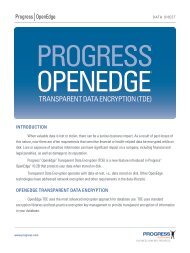OpenEdge 11 - Progress Software
OpenEdge 11 - Progress Software
OpenEdge 11 - Progress Software
You also want an ePaper? Increase the reach of your titles
YUMPU automatically turns print PDFs into web optimized ePapers that Google loves.
3. Network compression for state-free AppServer mode, Java<br />
OpenClient, and .NET OpenClient<br />
Message compression improves application performance on a<br />
network. In <strong>OpenEdge</strong> <strong>11</strong>, AppServer messages are compressed when<br />
operating in state-free mode and communicating with any client. This<br />
completes compression work for all modes of the AppServer. In addition,<br />
the Java and .NET OpenClient include compression as well.<br />
*New AppServer functionality for <strong>OpenEdge</strong> <strong>11</strong>.1 includes:<br />
4. TCP Keepalive properties for the .NET OpenClient<br />
In <strong>OpenEdge</strong> <strong>11</strong>.1 the .NET OpenClient supports runtime properties<br />
that allow direct control of the TCP socket’s Keepalive messages, allowing<br />
applications to adapt to the needs of the network that the application is<br />
operating within.<br />
*New AppServer functionality for <strong>OpenEdge</strong> <strong>11</strong>.2 includes:<br />
5. REST Adapter<br />
The <strong>OpenEdge</strong> <strong>11</strong>.2 REST Adapter leverages the power of XML to give<br />
your application the ability to integrate with any other application, written in<br />
any language and on any platform. This provides access to the AppServer by<br />
any client built outside of <strong>OpenEdge</strong> and opens up your application to a world<br />
of unlimited connectivity, to any app on any platform.<br />
6. Improved AppServer Performance<br />
<strong>OpenEdge</strong> <strong>11</strong>.2 improves AppServer performance for single-run<br />
and singleton persistent procedures. Operations that previously required<br />
multiple round trips from the client to the AppServer are now accomplished<br />
with just one round trip.Single-run procedures apply to the frequent case<br />
where an application needs to run a persistent procedure just one time. The<br />
Single Run combines the three separate calls for Create, Run, and Delete<br />
of the procedure into a single call that executes them all together, resulting<br />
in just one round-trip where previously three were necessary. For Singleton<br />
procedures, the persistent procedure is instantiated only if it is not already<br />
running from a previous invocation, and remains instantiated after each run.<br />
www.progress.com<br />
14





